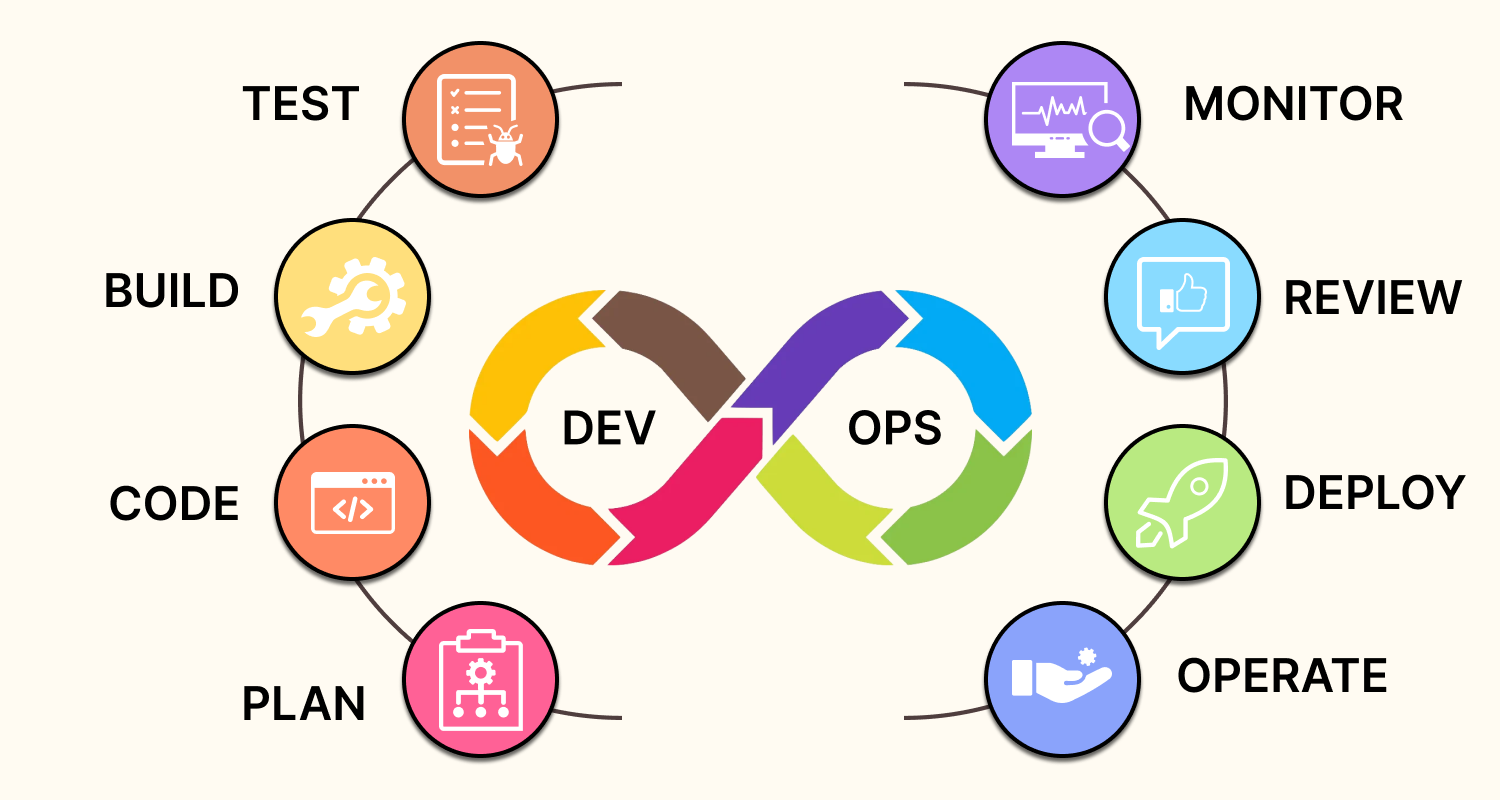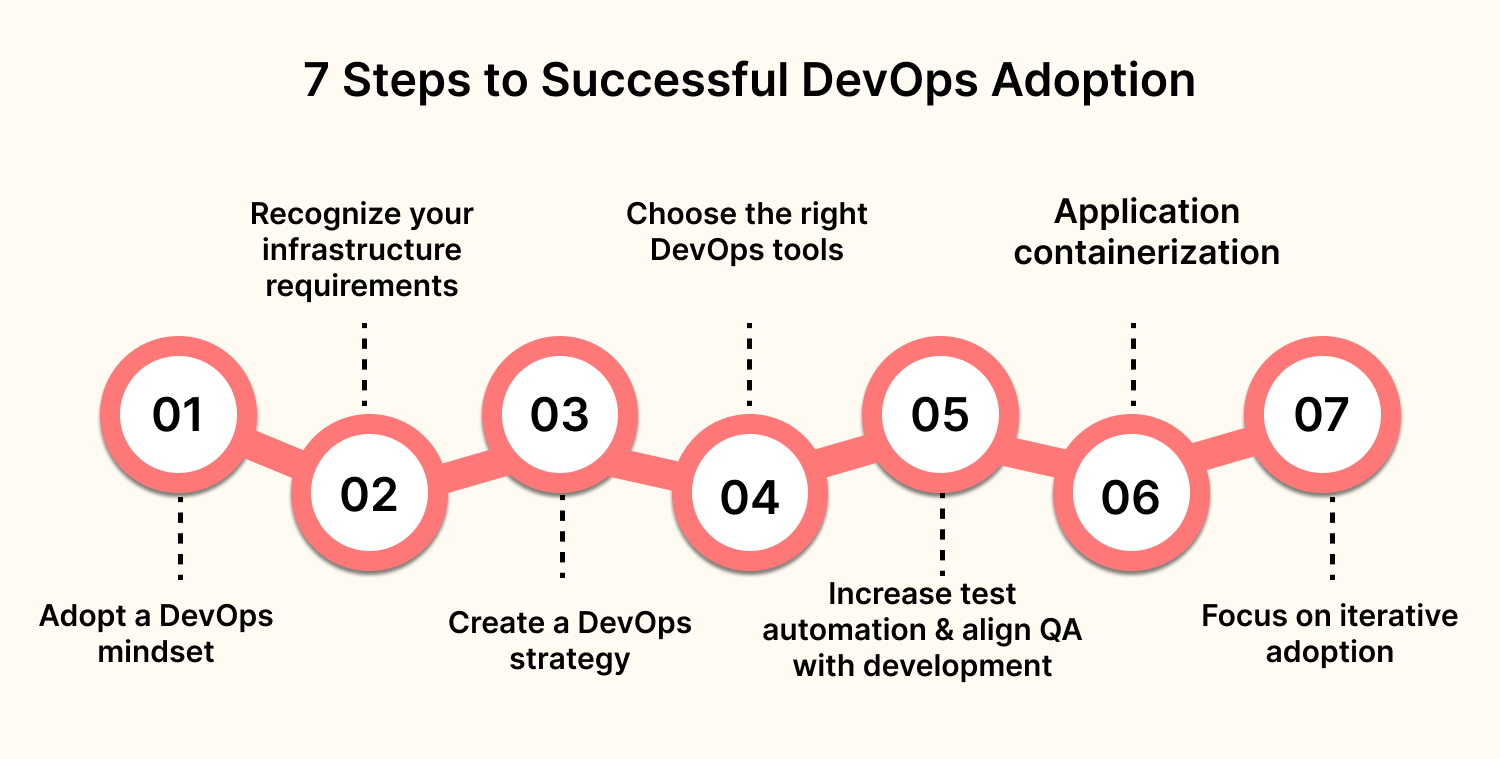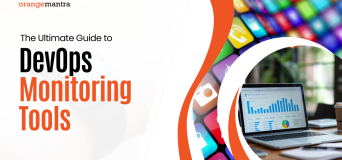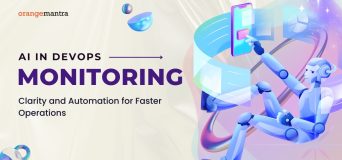More and more IT teams are choosing DevOps to build and deliver software faster. In fact, 49% of organizations now use DevOps, making it the top process framework. The second most used framework is agile, which is used by 36%.
There are many benefits that DevOps solutions provide to the implementer. Afterall, its market is reaching $25.5 billion in the next three years (reported by MarketsandMarkets). The growing use of DevOps solutions across companies marks a big step forward in digital transformation.
With the rise of modern cloud tools, big organizations are bringing their development, security, and operations teams closer together. A good DevOps implementation roadmap helps them work better and grow in a steady and smart way.
Table of Contents
Why DevOps Adoption is Challenging (But Worth It) ?
Adopting DevOps isn’t always easy. For many companies, it can feel overwhelming and often becomes a major hurdle when trying to fully use their IT infrastructure. As automation and performance expectations grow, DevOps is essential.
Tech teams across the world have tried different ways to adopt DevOps solutions. Some failed, but many found success and laid the foundation for long-term use.
Still, the rapid growth of DevOps can sometimes slow down full transformation, especially when trying to change every part of the development pipeline.
The benefits are clear: faster software releases, better scalability, higher code quality, and stronger risk management. But getting there takes effort. Let’s break down what it takes to implement DevOps successfully in large organizations.
What Is the Role of Enterprise DevOps Solutions?

Enterprise DevOps solutions play a key role in helping large organizations improve how they build, test, and deliver software. Unlike basic DevOps practices, enterprise-level solutions are designed to scale across large teams, complex systems, and strict security requirements.
At its core, DevOps is not a tool or framework but a way of working that brings development and operations teams together. For enterprises, this means automating processes and improving collaboration across departments.
Here’s what makes enterprise DevOps solutions essential:
- End-to-end automation of the CI/CD pipeline for faster release and with fewer errors.
- Detailed process mapping to align automation with specific business needs
- Strong focus on security and compliance.
- Better scalability and reliability, even in complex systems with many interdependent parts.
- Boosted efficiency by reducing manual tasks and streamlining workflows.
Enterprise DevOps becomes especially useful when companies face challenges like:
- Managing outdated and monolithic software systems
- Relying on manual processes that slow down delivery
- Handling multiple connected subsystems that must work together
- Operating in traditional, waterfall-based environments that need modernization
What are the Advantages of DevOps Implementation?
DevOps brings together people, processes, and tools to deliver software faster, with better quality and security. When done right, DevOps solutions help teams work more efficiently and deliver real value to end users continuously. Here are the main benefits of DevOps implementation for enterprises:
Happier and More Engaged Teams
DevOps gives employees more control over how they work. With the freedom to improve tools, processes, and workflows, teams feel more engaged and motivated. This sense of ownership helps create a positive work culture, reduces friction, and attracts top talent.
Improved Workflow and Faster Delivery
DevOps helps eliminate bottlenecks in the software development process. It improves workflows and introduces automation. Teams with DevOps can deliver features faster, respond quickly to customer needs, and reduce time-to-market. This agility gives businesses a competitive edge.
Automation of Repetitive Tasks
Automation is one of DevOps’ biggest strengths. It reduces manual work, cuts costs, and improves accuracy. Tasks like testing, deployment, and code reviews can be automated. It frees developers to focus on higher-value work and speeds up delivery.
Stronger Collaboration Across Teams
DevOps promotes a culture of collaboration between development, operations, security, and other departments. This shared responsibility improves communication and helps teams work together toward common goals.
Support for Business Transformation
DevOps helps businesses transform how they build and ship software. How? By combining automation, collaboration, and continuous improvement. It enables scalable, secure, and reliable systems which are always ready to meet fast-changing market demands. Integrating AI with DevOps can further accelerate innovation.
How to Successfully Implement DevOps Solutions in Enterprises?

The idea of DevOps is not new, but many firms lack an understanding of this entire practice. Also, some organizations face trouble using DevOps assessment to achieve their desired results. If it sounds like you, here is the DevOps implementation roadmap to your enterprise.
Practice a DevOps Mindset
The DevOps implementation roadmap starts with a clear picture of how DevOps addresses your business demands. Every stakeholder in the organization must have the mindset to change the way things get done.
Organizations frequently misunderstand automation as DevOps. While automation helps speed up manual operations, cooperation and communication are the key objectives of DevOps.
The best way to implement DevOps solutions is to make sure everyone is on the same page and has an innovative mindset. Employees participating in the process should be aware of their job responsibilities and well trained to follow the organization’s work culture.
The leaders (like managers and executives) need to trust that DevOps implementation roadmap will bring positive results. They also need to actively encourage and promote a work culture that embraces DevOps principles.
Understand the Organization’s Infrastructure Requirements
You know what – there is no “one size fits all” DevOps solution. You cannot hire DevOps developer or switch to an online tool for a successful result.
Every organization’s DevOps implementation roadmap will be unique and based on its business culture, work processes, and infrastructure. The most significant step to success is to have an in-depth knowledge of your application’s requirements.
Examine your project delivery cycle and testing environments to find areas of improvement and possible bottlenecks. Also, your DevOps adoption won’t be successful without the integration of CI/CD (Continuous Integration and Continuous Delivery) pipelines into your workflow.
Create a Robust DevOps Strategy
The program managers must establish a shared objective to bring teams together in a comprehensive setting. The goal should be to add a sense of responsibility and obligation to every team member.
DevOps implementation roadmap relies on best practices that promote innovative approaches to software development, architecture, and testing. Every organization’s strategy must focus on two objectives – helping the team as a whole and facilitating the continuous deployment of processes that are ready for production.
Choose the Right DevOps Solutions & Tools
There isn’t a single tool that can manage all the demands and key purposes of DevOps. The best solution is to choose a set of tools that are ideal for the organization’s software delivery environment, applications, teams, and so on.
What Makes a Good DevOps Toolset?
You should focus on the following when choosing DevOps tools:
Enterprise-Grade Automation:
Tools should support full-scale automation across environments, pipelines, testing, and deployments. This helps reduce manual effort, speed up delivery, and scale operations easily.
Seamless Ecosystem Integration:
DevOps thrives on collaboration. Tools in your DevOps implementation roadmap must integrate well with existing systems; including code repositories (like Git), CI/CD platforms (like Jenkins, GitHub Actions), cloud providers (AWS, Azure), and DevOps monitoring tools.
End-to-End Test Automation:
Fast delivery is only possible with strong test automation. DevOps teams should automate unit, integration, and regression tests. But not everything should be automated; usability, exploratory, and security testing often need manual attention.
QA and Development Alignment:
Quality assurance (QA) should not be a separate phase in your DevOps implementation roadmap. DevOps encourages test-driven development and continuous testing.
The Goal: Stability + Speed
The right tools with best practices in DevOps implementation roadmap let teams to:
- Shorten release cycles
- Catch and fix bugs earlier
- Avoid post-deployment failures
- Free up developer time for innovation
For example, container tools like Docker or Kubernetes make your apps portable and consistent across environments. They isolate services. With these tools, it’s easier to deploy updates, roll back issues, and improve resilience.
Application Containerization
Application containerization is a rapidly developing technology that alters how cloud-based application instances get tested and run by developers. For instance, your program becomes lightweight and simple in execution when containerized.
Software, when used, increases reliability with container packaging. Additionally, the software becomes independent of the broader infrastructure, thanks to its container components. It improves its ability to operate independently in any context.
Containerizing enables DevOps teams to quickly manage the application and make the adjustments required for a specific microservice.
Focus on Iterative Adoption
Avoid launching an end-to-end DevOps implementation roadmap in the enterprise while just getting started for obvious reasons. Instead, choose a pilot application, and put together a cross-functional DevOps team made up of developers, testers, and operations personnel.
Also, you can assess your value stream to discover bottlenecks and restrictions and develop a preliminary deployment pipeline that requires a few process constraints to be considered.
Track your success and growth, then repeat the process of DevOps implementation roadmap. Before thinking about expanding the additional projects, assess a few iterations to gain trust in the framework and the pilot.
What are the Major Challenges in DevOps Implementation Roadmap?
We’ve discussed how to adopt enterprise DevOps and some of the advantages of implementing it in your workflow culture.
However, it is not easy to consider all the factors and implement DevOps perfectly in your organization’s ecosystem. Let’s discuss the challenges associated with DevOps services and solutions.
Cultural Resistance
Changing an organization’s culture is the toughest part of DevOps adoption. DevOps demands collaboration and shared responsibility.
To shift this mindset:
- Encourage grassroots efforts and innovation.
- Support early adopters who drive cultural change.
- Give teams the autonomy to experiment and improve.
- Align everyone around common business goals.
Cultural change requires ongoing commitment from leadership and continuous support at every level.
Tool Overload or Gaps
DevOps is about using the right tools in the right way. Many teams adopt too many tools without integration. This mistake leads to confusion and inefficiencies.
What to do instead:
- Build a cohesive toolchain that supports your delivery workflow end-to-end.
- Avoid focusing only on tools. Focus on people, process, and outcomes.
- Choose tools that align with your team structure, delivery goals, and tech stack.
- Tools should simplify your delivery; not add more complexity.
Lack of Visibility and Flow
DevOps adoption requires transparency across the entire software delivery process. If your teams don’t understand how work flows from idea to production, they can’t optimize it.
To fix this:
- Map out value streams – how features or products move through the system.
- Visualize bottlenecks, handoffs, and delays.
- Make workflows visible to everyone, not just leadership.
Standardization and Data Usage
Standardized platforms and environments help reduce complexity and errors. But getting there can be difficult, especially in large enterprises with diverse tech stacks.
Here’s how DevOps adoption helps:
- Standardized environments (like using containers or infrastructure as code) reduce “it works on my machine” problems.
- Shared metrics and dashboards improve collaboration between dev, QA, and ops.
- Teams gain more ownership and accountability over their environments and tools.
Quality and Security Ownership
In traditional models, developers build software and toss it over to QA and security teams. But DevOps blurs these lines, and everyone is responsible for quality and security.
This mindset shift is challenging. Key improvements to make in DevOps implementation roadmap:
- Integrate automated tests and security checks early in the pipeline.
- Adopt DevSecOps – where dev, security, and ops collaborate from the start.
- Move security and quality practices “left” (earlier) in the development process.
- Treat security as a shared responsibility, not a gate at the end.
How to Start with DevOps Adoption?
It’s a common practice for many organizations to replace their practices with popular DevOps best practices for business needs. However, it doesn’t work in every situation.
Therefore, don’t replace what works best for you. Instead, introduce some new adjustments to efficiently minimize risks and increase workplace efficiency. Here are a few things you can get started with:
Change the Work Culture Environment
To begin with, it’s evident to have cross-functional teams who can take ownership of the development, security, and operational functions of their products. For this integration to be successfully launched, synergy and collaboration between the areas are a must.
Prioritize Learning
Building a work culture where learning is essential will truly move toward success. Invest in team learning to improve the quality of value delivery and improve your organization’s employee retention and new talent acquisition. Many organizations are focusing on immersive learning and enablement practices to upskill the team.
Unlike traditional corporate training, immersive learning focuses on team uplift on their actual work and within the existing constraints. With repetition and coaching support, the team grows and upskills to effectively learn for long-term success.
Continuous Integration
If your team hasn’t adopted a robust continuous integration practice, emphasize it on a priority basis. With continuous integration, code gets built and reviewed with a series of automated testing at every check-in.
It prevents quality risks and provides early feedback that developers can address right away. Furthermore, some of these tests should be done for local development to hold themselves accountable for fast, cost-effective feedback prior to pushing up their changes.
Implement Test automation
Automated tests are evident throughout the software delivery lifecycle. Developers must primarily focus on creating and maintaining automated test suites. Throwing any of the work to another team is a severe concern and must be addressed as a high priority.
Constant Delivery
Every product team is expected to deliver continuously. The software must be in a deployable state throughout its lifecycle, and the team should prioritize keeping the software in a deployable state while working on other features.
With continuous integration practices in place, the team will have the confidence to commit to deploying to production environments. Any impediments in this cycle should be made visible and addressed immediately.
What are the Key Principles for DevOps Implementation at Scale?
We’ve discussed some practical tips for enterprise DevOps implementation. Now, let’s look at some fundamental principles to keep in mind while implementing DevOps in your organizational workflows.
Principle 1: Centralized End-to-End Management
Get a centralized management system for your DevOps solutions pipeline with both development and deployment teams to operate as centrally managed teams. The goal is to ensure better visibility for all development and operational teams.
Principle 2: Security is Paramount
Enterprise DevOps consulting services must focus on security and compliance-related issues from the start of the software development lifecycle.
Maintain continuous and automated scanning at the database level, enable universal compliance issues, and set up governance teams to monitor rules and compliance policies.
Principle 3: Cloud-Native Modernization
Move to a cloud-native environment to gain a competitive advantage and offer effortless infrastructure management. With serverless platforms like AWS Lambda and Azure, organizations can manage networking, storage, and cloud provisioning with ease.
Principle 4: Pipeline as a Code
It is a standard practice of defining deployment pipelines via source codes. It will help reduce the developer’s workload and allow them to standardize and automate the process of software development.
Wrapping up
There is a diverse range of tools, practices, and working patterns that companies can implement to achieve a successful DevOps adoption. Therefore, it is crucial to look for things that can meet all the demands and specifics of your organization and its work culture.
The benefits of DevOps implementation roadmap create a direct impact on the overall result of the enterprise, which consequently results in business success.
Remember – your people are your asset in sustaining and growing your business. So, invest in your resources, enable, and empower their knowledge and working skills.
Are you looking for DevOps experts who can offer you end-to-end solutions? hire a DevOps engineer from OrangeMantra to accelerate your development pipeline and business growth.
FAQs
Q: What are the correct DevOps practices to include when adopting DevOps?
Some of the key practices are continuous integration, continuous delivery, automated testing, infrastructure as code, monitoring, and strong collaboration. These help teams work faster, reduce errors, and deliver better software more often.
Q: What are the main benefits of DevOps adoption?
DevOps adoption brings faster delivery, better product quality, fewer bugs, and improved teamwork. It also helps reduce downtime and improves customer satisfaction by keeping software updates frequent and reliable.
Q: What is the DevOps delivery model and how does it work?
The DevOps delivery model is a way to build, test, and release software quickly and continuously. It includes everything from planning to deployment with automation and collaboration across teams. This model helps reduce delays and improves software reliability.
Q: What should be the focus during DevOps adoption for enterprise?
Enterprises should focus on changing the work culture, automating processes, building cross-functional teams, and choosing tools that match their goals. DevOps adoption for enterprise needs leadership support, training, and a step-by-step rollout for success.




